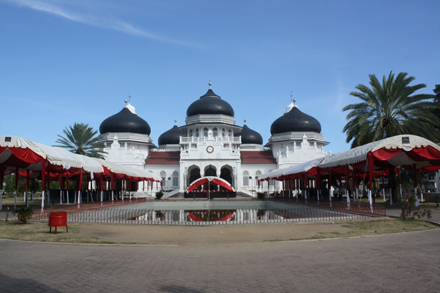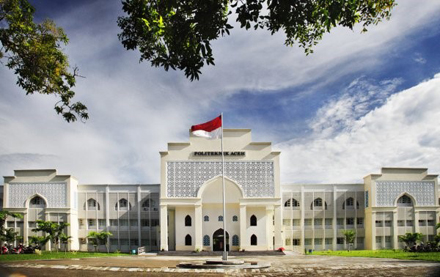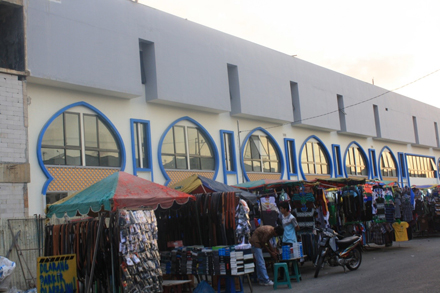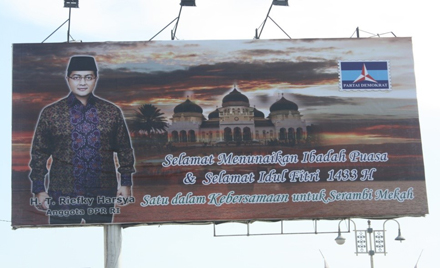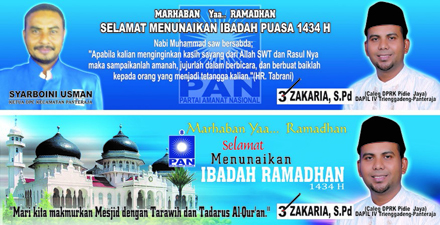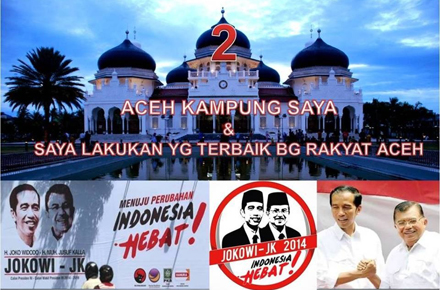Dewi Cut reports on how architecture, and a mosque in Aceh, is influencing political candidates and their election messages.
In 2012, driving along the major roads of Banda Aceh, I noticed numerous billboards. They featured a smiling figure wishing Ramadhan and Idul Fitri greeting backgrounded by the Baiturrahman Mosque. These would-be politicians were still two years from the campaign trail and yet there they were, brandished on billboards, their smiling faces becoming every more familiar to passing future voters. It’s common enough for politicians to jump on the seasonal greeting bandwagon, but why do Acehnese politicians uniformly use the Baiturrahman Mosque in their campaign imagery?
In modern Aceh, the Baiturrahman Mosque is the symbol of the “Verandah of Mecca” (Serambi Mekkah).
It’s believed that the mosque was first built by Sultan Iskandar Muda around 1607-1636. It was then then destroyed by the Dutch colonial forces during the long, agonising Aceh War from 1873 to 1942. This war was the most expensive war the Dutch ever fought and precisely because of its sheer intractability, Anthony Reid writes that the Dutch dedicated a lot of effort and money to winning hearts and minds. Rebuilding the mosque in 1879 was one such effort, though it failed to yield a peace agreement.
The iconic status of Baiturrahman increased during the 1950s when the local Acehnese government used it extensively to promote the image of Aceh as an Islamic society. Even for those without much Islamic or architectural literacy, this mosque is beautiful. The mosque has a unique architectural style. Its domes and arches were modelled on Moghul architecture, as well as mosque styles popular in Cordoba, Spain. The materials for the mosque, especially its old facade were imported.
To maintain this landmark and its iconic status the Spatial Planning law [Qanun/Undang-Undang Tata Ruang] clearly stipulates that the buildings around the mosque should not be higher than the minaret of the mosque and should function in accordance with the holy intents of the mosque. For example, surrounding buildings may not operate as hotels, karaoke centres, or have other entertainment that are in conflict with the mosque.
Daly and Rahmayati argue that mosques after the tsunami gained enormous symbolic value as they were some of the few buildings that kept their structural integrity. As local understand it, the architectural durability of the mosque and its ability to provide shelter was seen as a miracle from God. A short piece of footage taken from outside the Baiturrahman Mosque during the tsunami went viral. During the tsunami thousands of people found refuge inside while outside the mosque complex, the waters gush violently. In Banda Aceh alone 27,980 people were killed. Adding to the significance of the place, the Baiturrahman Mosque management board opened up three days after the disaster, serving as a meeting point, temporary shelter for victims and as always, a place of prayer.
In post-independent Indonesia, the architectural style of this mosque has induced other buildings in Aceh and across the country, to follow its soaring domes, arches, and ornamentation. In the ongoing debate of about Indonesian architectural identity, some argue that the Baiturrahman mosque is responsible for the shift in mosque architectural styles from the three-tired roof, popularly seen as a more “authentic” “Indonesian” mosque style, to the dome in keeping with an “international Islamic” style. The Baiturrahman has also left an imprint on commercial and public building styles. For example, the Pasar Aceh shopping centre, located just next to the mosque, has adopted the arches to suggest continuity with the mosque. So too the does Aceh’s technical college, the Politeknik Aceh, just a kilometre away, adopt the Baiturrachman’s details and arches.
Given this history, it is unsurprising that the emerging local political candidates use the mosque in their campaigning. In post-Sharia Aceh, the mosque lends familiarity and piety to an electoral campaign. Take this billboard as an example. The politician stands before the Baiturrahman mosque lit by sunset, giving the image a sense of tranquillity. He shares his greetings for Ramadhan and Idul Fitri and reminds Acehnese to stay unified as Mecca’s Verandah. Though the candidate doesn’t live in Aceh, but is of Acehnese descent, he reminds voters that he’s just like them. The mosque in its calmness reinforces the candidate’s identity as an Acehnese, a Muslim, a person of inner calm but with a strong vision for the unity of Aceh. It’s a seductive combination.
- Source: Teuku Alaidinsyah.
Around Banda Aceh and even in Jakarta, publishing companies offer Photoshop templates with the Baiturrahman mosque in the background, leaving given blanks for a candidate to insert their party logo, name and details as in the photo below.
Recently, I came across a Facebook campaign designed by Aceh’s Jokowi supporters. Campaigners combined images of the mosque with those of Jokowi and Kala on the campaign trail to promote Jokowi to other Acehnese facebookers. There is a strong tone of care and nurture in this image: the text across the front of the mosque says “Aceh is my home and I will do what’s best for the Acehnese community”.
Unsurprisingly, Baiturrachman has become an important site of pilgrimage for the Indonesian political elite, to pray and announce their public statements. This was especially so during the thirty-year conflict in Aceh with the central government. Like the Dutch, the Indonesian central government expected to reach a peace agreement using Baiturrachman’s “holy” persuasion.
Megawati’s performance at Baiturrahman in particular resonates in the collective Acehnese memory. On July 29 1999, while still Vice President, Megawati wept and with a conciliatory tone promised, “especially to my brothers and sisters in Aceh, I ask your patience. When Cut Nya [Acehnese for an aristocratic female leader) leads this country, I shall not allow a single drop of the people’s blood to wet your sacred land, a land that made such a huge contribution to making Indonesia free. To all of you I shall give my love, I shall give you your arun [oil fields], so that the people can enjoy the wondrous beauty of Mecca’s Veranda… The day of victory is coming and it will not be long. I beg your patience”. This “holy” promise she then denied making in 2003 when, now as President, she declared martial law.
More recently, on his own campaign visit, presidential candidate Prabowo went to Baiturrachman’s to borrow from the building’s “blessing”. He prayed zuhur [midday prayer] before jumping into serious political business. By performing piety, Prabowo evidences his Islamic identity and makes an appeal to Aceh’s voters. Will these final campaign days see Jokowi at Baiturrahman Mosque? Iconic architecture is not only seductive to building lovers and architects, but it wield irresistible appeal to the country’s politicians.
Dewi Cut is PhD candidate at the Australian National University’s College of Arts and Social Sciences, and is a Department of Architecture, Syiah Kuala University.
 Facebook
Facebook  Twitter
Twitter  Soundcloud
Soundcloud  Youtube
Youtube  Rss
Rss 